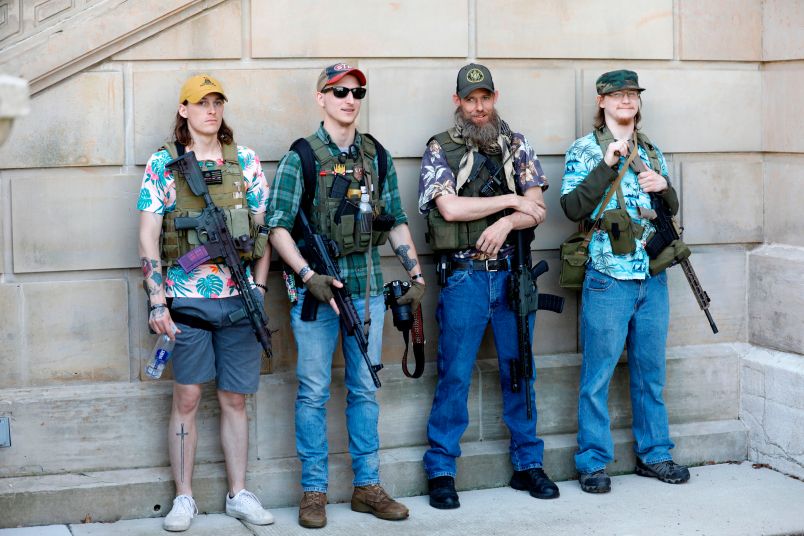If you’ve stayed up-to-date with coverage of the so-called “boogaloo” movement these past few months, you’ve probably noticed something about its most prominent adherents: Many are active-duty military or veterans.
Steven Carrillo, who’s accused of killing a Federal Protective Service officer and a sheriff’s deputy a week apart, was part of the Air Force’s Phoenix Raven program, an elite security detail. In Nevada, three men — an Army reservist and veterans of the Air Force and Navy — were arrested for an alleged plot to deploy Molotov cocktails at a Black Lives Matter rally.
And, last year, the Army veteran Brian Isaac Clyde was shot dead by law enforcement after opening fire outside a federal building in Texas.
This pattern is in part because armed extremist groups, including boogaloo-oriented groups, tend to look to the military for combat experience that others drawn to their movement don’t have, said Daryl Johnson, a domestic extremism expert with experience at DHS, ATF and the U.S. Army.
“They look to military members for leadership roles, as well as to teach tradecraft,” Johnson told TPM. “The patriotism part of the militia movement really appeals to the military members, who are already very patriotic by serving our country in the way they do.”
The term “boogaloo” comes from the mediocre movie sequel “Breakin’ 2: Electric Boogaloo,” which — after several internet spin cycles — became shorthand for a sequel to the Civil War. Now, it can refer to any armed confrontation with the federal government. Many boogalooers come from neo-Nazi and white nationalist groups, though not all accept those labels. And some are a part of ad-hoc “militias.”
It sounds a bit upside-down that members of the military — sworn to protect the Constitution and required to follow a command structure all the way up to the President — would support overthrowing the government. But that friction is central to the messaging of the boogaloo movement, and among the militia movement more generally.
Fringe media organizations, Johnson said, “paint this bleak picture of America, like, ‘America is falling’ and ‘Our constitutional rights are being trampled on and eroding.”
“When you consume yourself with that type of propaganda, it changes your mindset,” Johnson said. “It creates paranoia and fear.”
The boogaloo movement takes these libertarian concerns, particularly over gun rights and aggressive policing tactics like no-knock raids, to extremes.
Ultimately, Johnson said, that means advocating for an armed response.
And though the military prohibits “active” participation in extremist groups, soldiers can rationalize their membership in boogaloo and other groups by keeping their participation primarily online, he said.
One notable case that’s flown somewhat under-the-radar is that of Noah Latham, a 22-year-old who, according to his arrest report, is an Army drone operator.

Latham faces a felony charge for allegedly carrying a loaded handgun with no serial number in his waistband at a Black Lives Matter protest last month in Troy, New York.
Several others in Latham’s group that day have been charged on weapons violations as well, and prosecutors say that a tactical manual recovered at the scene tied the group to the “New England Minute-Men,” an armed group operating mostly out of New Hampshire. (Latham and others arrested that day have all pleaded not guilty.)
Another member of the New England Minute-Men, “Mark,” told TPM that he’d previously served as a National Guardsman, and that several NEMM members were involved in the military — including one or two who are still active-duty.
Mark didn’t give his full name, but he’s become a “face” of sorts for the boogaloo movement. Known as “MarkofdaBoog” on Instagram, Mark’s anonymous mug has been used on dozens of articles and reports about the movement.
New: Facebook is “designating a violent U.S.-based anti-government network (the Boogaloo movement) as a dangerous organization and banning it from our apps.”https://t.co/0qAVEue3Hj
— Ben Collins (@oneunderscore__) June 30, 2020
He told TPM over the phone that around half of NEMM members would identify as boogalooers. Mark has passed out pamphlets with NEMM about “the Boogaloo and you.”
“We’re told that we go overseas and fight for freedom, while our own government is stealing the freedoms from us while we’re out overseas,” he told TPM.
That pitch to soldiers comes with some contradictions. Mark called NEMM a “constitutionalist militia,” but asserted that the democratic process has failed at protecting Americans’ rights — primarily gun rights.
“The means of petition, protest and voting have been exhausted,” he said, and some type of violent confrontation is “inevitable.”
Howard Graves, a senior research analyst at the Southern Poverty Law Center, told TPM that the boogaloo movement’s ties to the military were “consistent with trends we’ve seen in terms of extremist groups seeking out, attracting, and recruiting past and present members of the U.S. military.”
America doesn’t offer much support for veterans trying to reintegrate into life outside the military, he noted, and “extremist groups recognize that void.”
“They do their utmost to try and signal that they will be a welcoming place for these individuals,” he said — that “they’ll give them a sense of community, identity and purpose.”


 Members-Only Article
Members-Only Article
